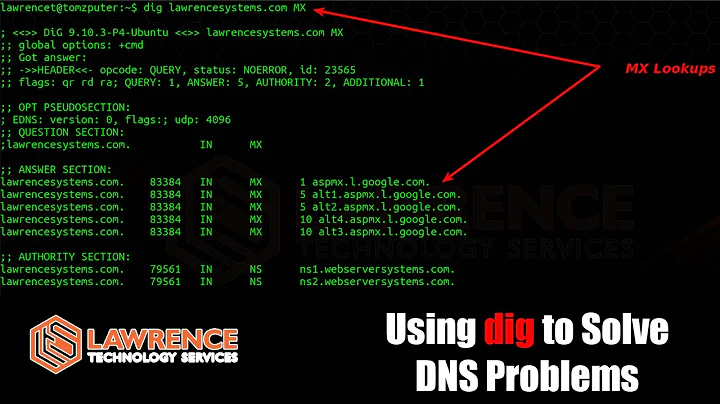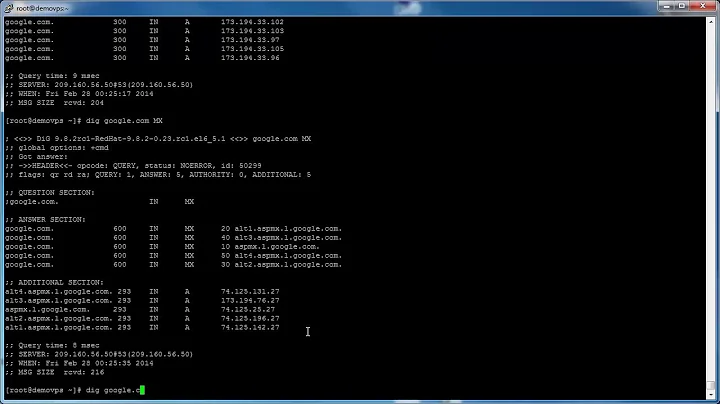What's the difference between `dig` and `host` when querying a specific name-server?
Solution 1
host, dig, and nslookup all share most of the same functionality. In the case you are asking about (asking a particular DNS question to a particular nameserver), dig and host (and indeed nslookup) behave exactly the same.
For DNS troubleshooting, dig is preferred because its output format is more "raw": in its output it directly shows the contents of all 4 fields in the DNS response: question, answer, authority, and additional sections (plus the flags in the header), and also it has more options. host, on the other hand, has a more user-friendly output format.
If you don't happen to need an option that one of the commands has and the others don't, or a piece of information that one of them outputs and the others don't, then it comes down to a matter of preference.
Solution 2
If you're using the non-FQDN hostname, the results can be different because host will use the search domains in resolv.conf, whereas dig does not by default.
You have to use the +search option if you want dig to use resolv.conf (or add it to ~/.digrc).
For example:
$ host foo
foo.myfqdn.com has address 10.1.2.3
$ dig +short foo
# (no result)
$ dig +short +search foo
10.1.2.3
Related videos on Youtube
Comments
-
jhabbott over 1 year
I was using this command to verify if I'd set things up correctly with a DNS provider:
host hostname.example.com ns1.example-nameserver.comAs far as I can tell, this asks
ns1.example-nameserver.comto look uphostname.example.comand reports the answer. I was getting a host-not-found response so I thought I'd done it wrong. However, without specifying their name-server (thus allowing my ISP's name-server to look it up) I got the correct response (hostnameis aCNAMEif it matters). I couldn't fathom this so I searched around and found thedigcommand:dig @ns1.example-nameserver.com hostname.example.comAs far as I can tell this does the same thing as the
hostcommand - asks a specific name-server to look up a host. I therefore conclude that they must do it differently somehow, and that caching name-servers must use the same method asdig.My conclusion is either right or wrong, if it is right:
What is the difference between these two look-up methods?
If it is wrong:
What are my misunderstandings about DNS and the
hostanddigcommands that have led me to this conclusion?Example output:
$ host cardiff.tzmchapters.org ns1.livedns.co.uk Using domain server: Name: ns1.livedns.co.uk Address: 213.171.192.250#53 Aliases: Host cardiff.tzmchapters.org not found: 3(NXDOMAIN) $ dig @ns1.livedns.co.uk cardiff.tzmchapters.org ; <<>> DiG 9.8.3-P1 <<>> @ns1.livedns.co.uk cardiff.tzmchapters.org ; (1 server found) ;; global options: +cmd ;; Got answer: ;; ->>HEADER<<- opcode: QUERY, status: NXDOMAIN, id: 23620 ;; flags: qr aa rd; QUERY: 1, ANSWER: 1, AUTHORITY: 1, ADDITIONAL: 0 ;; WARNING: recursion requested but not available ;; QUESTION SECTION: ;cardiff.tzmchapters.org. IN A ;; ANSWER SECTION: cardiff.tzmchapters.org. 3600 IN CNAME ghs.google.com. ;; AUTHORITY SECTION: google.com. 3600 IN SOA ns1.livedns.co.uk. admin.google.com. 1354213742 10800 3600 604800 3600 ;; Query time: 27 msec ;; SERVER: 213.171.192.250#53(213.171.192.250) ;; WHEN: Mon Apr 22 23:47:05 2013 ;; MSG SIZE rcvd: 128-
Renan about 11 yearsboth commands should work the same way in this case. Can you show the complete output of each command?
-
jhabbott about 11 yearsSo in that case, do
digandhostboth send the exact same query packet, get the exact same response packet (aside from any timestamps), but interpret it differently? Doeshostbail out as soon as it seesNXDOMAIN? -
mo.khorami almost 9 yearsFWIW I have the exact opposite problem on a specific subdomain. Using host on this specific subdomain provides the expected record showing that this particular subdomain resolves to an expected canonical hostname. However, when using dig on this particular subdomain - I receive a response that the record does not exist. Additionally navigating to this subdomain with a browser does not work. I've tried multiple times, checking for spelling mistakes, etc. The commands are clearly NOT working in the same way.
-
-
jhabbott about 11 yearsIf they do the same thing on the network side (the actual query) how can I be getting host not found when using
hostbut the correct answer when usingdig? Even if the server is configured using a particular setting (either by choice or accident) to cause this, it must be able to differentiate the requests. -
 Celada about 11 yearsNope! The two commands you give in your question are equivalent and they should produce the same answer! Are you sure that
Celada about 11 yearsNope! The two commands you give in your question are equivalent and they should produce the same answer! Are you sure thatdiggave you an actual answer and not a record in the additional or authority section? As Renan suggests, it might help to show the output. -
jhabbott about 11 yearsOk, I've added some example output. I get the same result at home and at work. When I don't specify a name server to use and my ISP handles the query,
hostworks fine. Please try it yourself and let me know the results. -
jhabbott about 10 yearsJust reviewing this - The ISP eventually told me that their server was configured not to respond to direct client queries, only to other nameservers asking for information transfers - does
digquery in a different way, like a nameserver would? -
 Celada about 10 yearsdig can do both regular questions (all types except AXFR) and zone transfers (type AXFR) but DNS operators usually restrict zone transfers to authorized slaves so you most probably want to use regular questions
Celada about 10 yearsdig can do both regular questions (all types except AXFR) and zone transfers (type AXFR) but DNS operators usually restrict zone transfers to authorized slaves so you most probably want to use regular questions -
 duozmo about 8 yearsFYI to fellow non-DNS admins:
duozmo about 8 yearsFYI to fellow non-DNS admins:dig’s output is based on the zone file format.;starts a comment, and record columns arename,ttl,record class,record type, andrecord data. BIND, of whichdigis a part, documents zone files elsewhere and omits this info fromdig’s man page. -
Pablo A about 2 yearsI'm getting much more info with
host, like IPv6 records I couldn't get withdig -6:dig @4.2.2.2 ehow.com; host -v ehow.com 4.2.2.2




